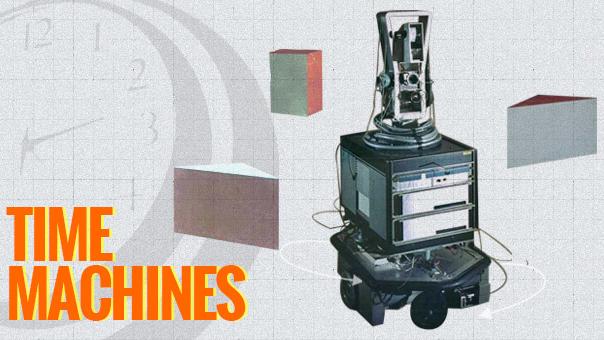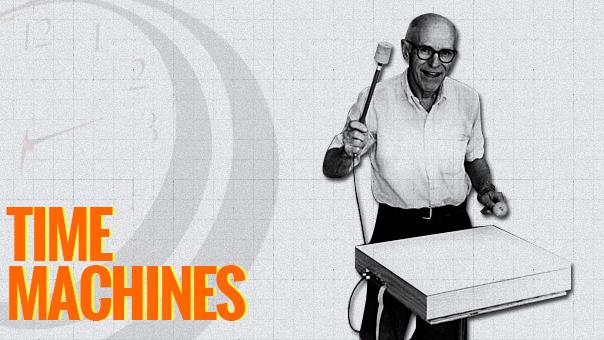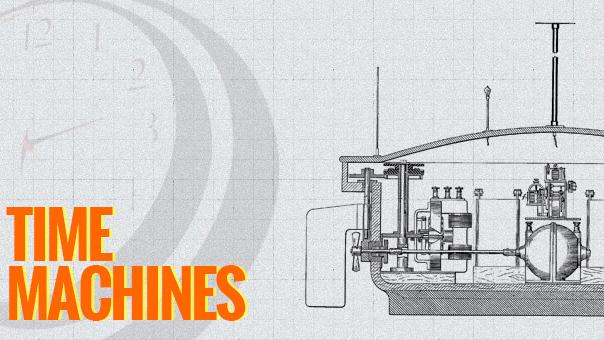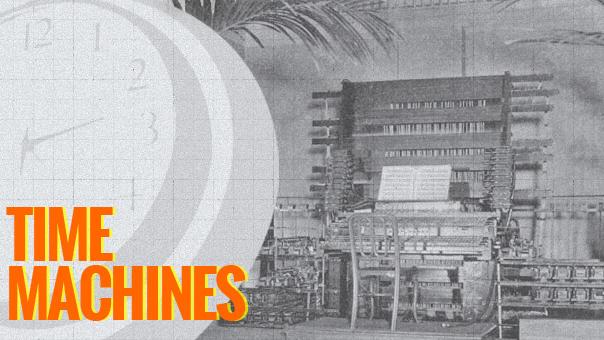TL18TMCH
Latest

Up, up and down: The ephemerality and reality of the jetpack
Welcome to Time Machines, where we offer up a selection of mechanical oddities, milestone gadgets and unique inventions to test out your tech-history skills. Born out of sci-fi cinema, pulp literature and a general lust for launching ourselves into the wild blue yonder, the real-world Rocket Belt began to truly unfold once the military industrial complex opened up its wallet. In the late 1950s, the US Army's Transportation Research Command (TRECOM) was looking at ways to augment the mobility of foot soldiers and enable them to bypass minefields and other obstacles on the battleground by making long-range jumps. It put out a call to various aerospace companies looking for prototypes of a Small Rocket Lift Device (SRLD). Bell Aerospace, which had built the sound-barrier-breaking X-1 aircraft for the Army Air Forces, managed to get the contract and Wendell Moore, a propulsion engineer at Bell became the technical lead.

The 'first electronic person' was a box on wheels
Welcome to Time Machines, where we offer up a selection of mechanical oddities, milestone gadgets and unique inventions to test out your tech-history skills. Some humans have enough trouble navigating an apartment without stubbing their toes, and that's with a robust onboard computer, finely tuned sensory apparatuses and years of practice in the field. Shakey was a pioneering bot under the tutelage of the SRI Artificial Intelligence Center's (AIC) research team, and it would take its share of bumps and wrong turns as it learned its way around the lab. It was born in 1966 as an artificial intelligence project to develop robots with the ability to navigate real-world environments and make decisions on the fly in order to overcome obstacles and solve complex problems. Life magazine even gave Shakey the title of "first electronic person" for its efforts in a 1970 article, vaulting it to near peer-level status with its toe-crunching creators.

The sights and scents of the Sensorama Simulator
Welcome to Time Machines, where we offer up a selection of mechanical oddities, milestone gadgets and unique inventions to test out your tech-history skills. You're perched atop a motorcycle, cruising through Brooklyn with the wind whipping through your hair. A faint waft of indefinable city-funk hits your nose and the rumbling of the engine rattles your backside. Then your tokens run out. You've just experienced the Sensorama Simulator, a machine from 1962 that played a 3D film along with stereo sound, aromas and wind in order to create an immersive sensory environment. It was one of many 3D-related creations that visionary inventor and cinematographer Morton Heilig gave the world. His ideas for adding layers of sensory stimuli to augment a simple cinema presentation led the way towards today's "virtual reality" experiences.

Max Mathews' one-man electronic orchestra
Welcome to Time Machines, where we offer up a selection of mechanical oddities, milestone gadgets and unique inventions to test out your tech-history skills. Conduct an electronic orchestra, right from your living room! It may seem like a fever dream headline from the 1950s, but the physical results of Max Mathews' years of work in computer music wouldn't fully materialize until the '80s. His Radio Drum (aka Radio Baton) -- although a continual work-in-progress -- was a groundbreaking method of controlling computer-synthesized sound through a predominantly wireless three-dimensional interface. Many of its unique abilities were courtesy of technological visionary Bob Boie's capacitance research, creating "a much more participatory way of enjoying music," as Mathews described in Stanford University's Brainstorm. The Radio Drum could track surface hits and even hovering positions, and use that data to control a multitude of audio parameters. It was one of many projects that Mathews worked on during his lifetime and played a part in earning him the honorary title of "Father of Computer Music."

GE's bringing good things, and massive robots, to life
Welcome to Time Machines, where we offer up a selection of mechanical oddities, milestone gadgets and unique inventions to test out your tech-history skills. America was in the middle of a post-war economic boom during the '50s and industries were in a rush to build the future, often with outlandish results. RCA-Whirlpool was busy whipping up the "miracle kitchen," chock-full of mod-cons to make the Jetsons jealous, and Simplicity Mfg. Co.'s air-conditioned, bubble-domed lawnmowers arrived to ease the painful process of landscaping. General Electric (GE), a longtime hotbed of innovation and research, had various projects underway, including engineer Ralph Mosher's Cybernetic Anthropomorphic Machine Systems (CAMS). Mosher was building man-amplifying tools that would allow users to control robotic appendages with natural human movement. Not to be left out, the US Army was plotting the future of rough- and remote-terrain vehicles, and it had its eye on GE and Mosher's work.

Tesla's toy boat: A drone before its time
Welcome to Time Machines, where we offer up a selection of mechanical oddities, milestone gadgets and unique inventions to test out your tech-history skills. The military complex has certainly embraced the concept of telerobotics, especially in the use of drones, but luckily the technology has also led to other, more peaceful applications. Drones have been used to entertain, take on laborious tasks and even deliver packages (and burritos!). As we pursue the development of remotely controlled and autonomous craft, we must tread carefully or suffer the same fate as the fabled Icarus. Nikola Tesla saw both the terrible as well as the beneficial consequences for this technology when he debuted the "remote control" and the jury is still out as to whether we'll succumb to a dystopian Terminator-style future or reach a peaceful stasis, where we harness the usefulness of robots and autonomous devices, and avoid the worst-case scenarios.

Time Machines: Dial-a-tune
Welcome to Time Machines, where we offer up a selection of mechanical oddities, milestone gadgets and unique inventions to test out your tech-history skills. This invention brought streaming music to New York City's early adopters around the turn of the 20th century. Mark Twain, who was among the first to have a personal telephone line installed, was an avid supporter of the service, which provided the crystalline clarity of electrically generated music delivered into his own home on the telephone wire. Head on past the break to find out the full story.
